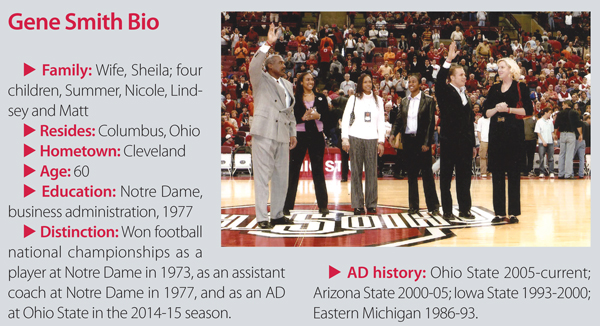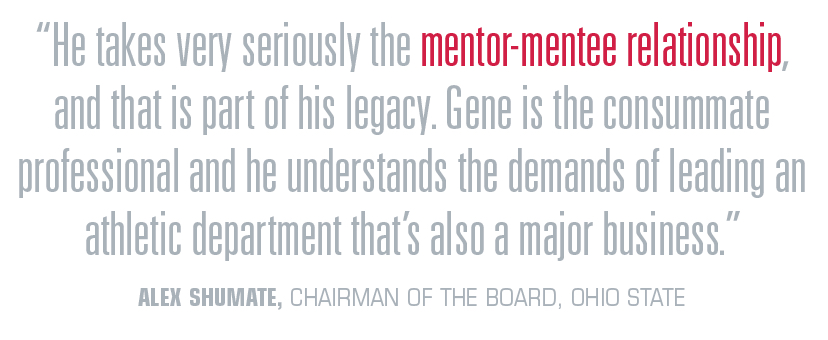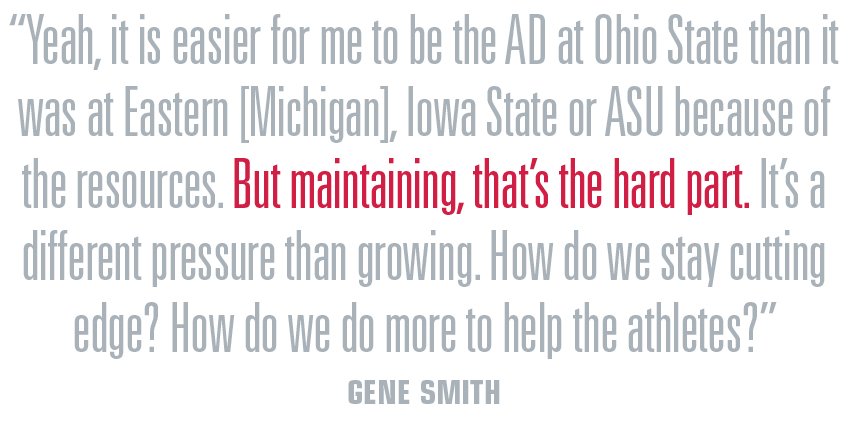Ohio State’s Gene Smith is fond of saying, “Don’t dance.” Whether he’s talking to a senior staffer, a coach or an athlete, he wants the unfiltered story.
On this early morning in 2010, Heather Lyke was dancing.
Smith was, and still is, the Buckeyes’ athletic director. Lyke was a senior associate AD and one of Smith’s most trusted lieutenants.
But it occurred to Smith one day that he didn’t know what her career goals were. So he called her into his office and asked a simple question:
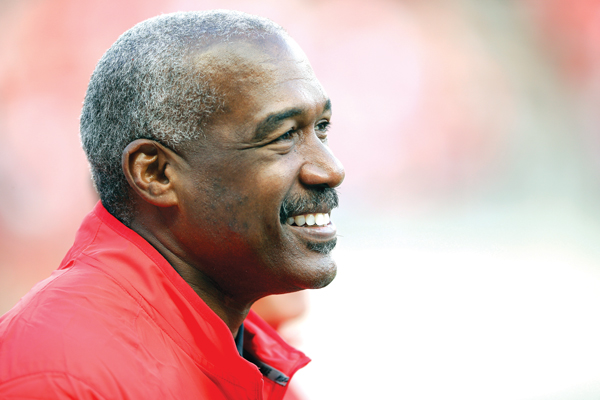 |
Ohio State's Gene Smith is the SportsBusiness Journal Athletic Director of the Year.
Photo by: Ohio State |
“Heather, what do you want to do?”
“Today? Oh, I’ve got a whole list of things to do,” she said.
“No,” Smith responded. “What do you want to do with your life?”
Lyke stopped in her tracks. She didn’t have an answer. She mumbled something about maybe going to law school, but the truth was that Lyke had spent so much time with her head down working that she hadn’t really contemplated the question.
“Heather, you’re dancing,” Smith said. “When you figure it out, let me know and I’ll help you.”
It was a two-minute conversation that changed her life. The more Lyke thought about it, the more she was sure she wanted to lead her own athletic department, but it took the exchange with Smith to draw it out of her. Now Lyke, with Smith’s help, is the AD at Eastern Michigan, where Smith started his career in administration more than 30 years ago.
“I did want to be an AD,” Lyke said from her Ypsilanti, Mich., office on Eastern Michigan’s campus. “But if you say it and don’t do it, does that make you a failure? Gene assured me that it didn’t. If you never put yourself out there, how will you know? That was one of many times where Gene knew the right thing to say.”
In many ways, Smith is the standard for the modern-day AD who also operates like a CEO. The old model of winning games, hiring coaches and managing the budget might keep the boosters off your back, but it’s never been enough for him. Playing football at Notre Dame in the 1970s changed Smith’s life, and it remains his inspiration to pay it forward.
Smith, as much as anyone in the business, has remade the AD job by creating professional development opportunities for his staff and putting programs in place that make it mandatory for Buckeye athletes to leave campus with a résumé, a set of contacts and an internship. He’s a mentor for aspiring ADs, as
Lyke attests, and he’s quick to share ideas, some of which can be found on other campuses.
Smith is the SportsBusiness Journal AD of the Year because of $70 million-plus worth of new facilities for Olympic sports, a then-record $252 million shoe and apparel deal with Nike and a high level of competitive success across the Buckeyes’ 36 sports.
But it’s those other things, his friends say, that define Ohio State’s athletic director.
“Gene has done more to put these kids in a position to succeed off the field, as well as on the field, and that’s going to be his legacy,” said Algenon Marbley, a U.S. District Court judge in Columbus who formerly served on Ohio State’s board of trustees. “It’s all part of the culture that Gene has built from his management style.”
■ ■ ■
The argument against Smith for the AD of the Year is that, with Ohio State’s resources as one of the richest athletic departments in the country, he can do more with more. With a $170 million budget, he doesn’t suffer from the fiscal limitations many others have.
In other words, a lot of ADs could look good at Ohio State.
And while there’s something to be said for having resources, it’s also been proved that money is no guarantee of success. It’s how you spend the money that counts.
Smith doesn’t take that as a knock. In fact, he acknowledges that there’s some truth to it. He yearned to implement more student-athlete enrichment programs at his other AD stops — Eastern Michigan, Iowa State, Arizona State — but funds simply weren’t as plentiful.
“Yeah, it is easier for me to be the AD at Ohio State than it was at Eastern, Iowa State or ASU because of the resources,” he said. “But maintaining, that’s the hard part. It’s a different pressure than growing. How do we stay cutting edge? How do we do more to help the athletes?
“The difficult thing I deal with is expectations. We have a men’s tennis team that has won 11 straight Big Ten championships. And everybody is upset that they got knocked out of the NCAAs in the final eight. We have to recognize the accomplishments that too often are taken for granted.”
Smith’s point is that after you’ve hired the best coaches and built the nicest facilities, what else do you do to help the athletes?
The answer started coming into focus for Smith years ago when an elite-level fencer came into his office. She had decided to abandon her pursuit of the Olympics, graduate from Ohio State and get a job.
“She had a 3.8 GPA, she’s drop-dead gorgeous and she speaks six languages, so I asked to look at her résumé,” Smith said. “All she had ever done was fencing. She had no idea what the work environment was like because she’d never had a job.”
Her story inspired Smith to create a program that requires athletes to write a résumé by the end of their sophomore
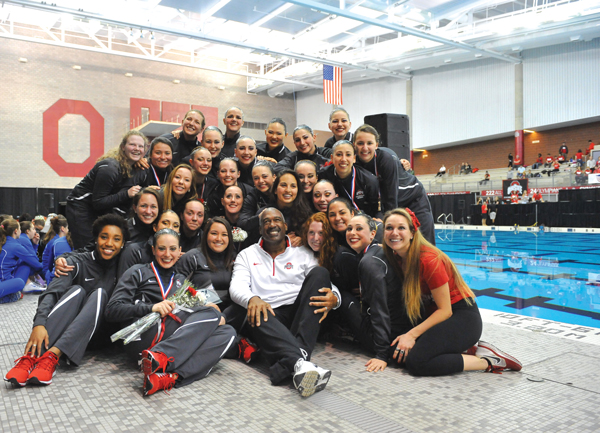 |
Whether it’s synchronized swimming or football, Smith has focused on helping athletes be successful beyond just sports.
Photo by: Ohio State |
year. Then he created an athletic department position to do nothing but work with athletes on how to find a job.
The program has expanded to include opportunities for athletes to shadow high-ranking executives around Columbus and intern on campus.
The student-athlete intern program — branded Bucks Go Pro — offers paid internships within 38 university departments, from the golf course to student life, finance, accounting, human resources, compliance, facilities and many more. They can learn how to manage a pro shop or an athletic department.
A campuswide sponsorship from Huntington Bank supports Bucks Go Pro. Athletes must apply and interview for each position, like they would any job.
When Smith negotiated the $252 million shoe and apparel deal with Nike, he kept those same priorities in focus.
One of the deal points was to increase the number of internships at Nike from two per year to eight, creating 90 new internship positions for Ohio State students over the course of the 15-year deal.
“We’ve created this culture where they’re thinking about getting a job now instead of waiting until their senior year and they have no experience,” Smith said.
A lot more high-resource schools across the country are doing this sort of training now, but Michigan AD Warde Manuel, a longtime friend, credits Smith with setting the tone with such programs.
“Gene is certainly one of the founders in believing that the AD’s job is more than taking care of tickets, the field and the budget,” Manuel said. “He’s developed the programs, he’s lived this philosophy.”
Manual knows because when he got his first AD job at Buffalo, one of the first programs he implemented was the required résumé.
“I had heard about it from Gene,” he said.
■ ■ ■
Smith is big on culture. He doesn’t necessarily believe in creating a vision for culture and chasing that vision. He’d rather do the little things, like asking a senior staffer about her dreams, and let the culture evolve from a multitude of those small acts.
“The best thing you can do is to help people get to where they want to be,” he said.
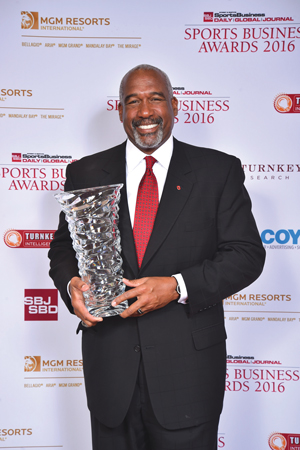 |
Smith was honored at last month’s Sports Business Awards.
Photo by: Marc Bryan-Brown |
The first thing Smith does every morning is check a database on his desktop that houses every one of Ohio State’s 350 athletic department employees and their birthday. Then he sends out a personal note to each person celebrating a birthday that day.
It’s not a huge deal, but if he can add up enough small gestures like that, just to let people know that he cares, it might become ingrained in the place.
“People might forget what you say, but they’ll never forget how you made them feel,” said Smith, a longtime and voracious reader of leadership books (see related item).
“He takes very seriously the mentor-mentee relationship, and that is part of his legacy,” said Alex Shumate, chairman of the board at Ohio State and managing partner at Squire Patton Boggs in Columbus. “Gene is the consummate professional and he understands the demands of leading an athletic department that’s also a major business.”
■ ■ ■
After that conversation with
Lyke six years ago, Smith worked with some of his senior staffers to build a program for professional development.
They called it the Group of 6 and it comprised six senior administrators who aspired to be athletic directors. Three, including Pat Chun at Florida Atlantic and Ben Jay at Hawaii, have since left for AD jobs, while others at Ohio State have joined the program, which is now the Group of 10.
They meet once a month or once a quarter depending on how busy they are, and Smith gives them carte blanche to ask about anything, whether they’re current events or decisions Smith made in the past. From Jim Tressel and the tattoo scandal to Cardale Jones’ complaints on Twitter about having to go to class, Smith’s 11 years with the Buckeyes haven’t been without drama.
Beyond those meetings, Smith facilitates time with other ADs. During a trip to the Rose Bowl, the group met with UCLA’s Dan Guerrero, who is one of Smith’s best friends in the business. On a visit to North Carolina, they met with the ADs at UNC, N.C. State and Duke. Smith also has flown in other ADs to Columbus, like Oklahoma’s Joe Castiglione, another close friend.
For one session, Smith brought in author and speaker Tim Elmore to talk about his book “Generation iY,” and community leaders like Shumate and Marbley have been invited as well.
“Gene is brilliant at that kind of thing,” Lyke said. “Yeah, he’s got resources to make that happen, but you’ve still got to lead. You’ve got to have accountability, good organization, good structure. If you don’t have the foundation, it doesn’t matter how much money you have, you won’t get the results.”
Lyke said Smith’s guidance came into play earlier this year when Eastern Michigan hired a new president. Smith, who has been through three presidents and two interim presidents in his 11 years at Ohio State, knows a thing about transition.
His advice to Lyke was to go visit the new president before he starts full time at EMU. Smith had done the same thing in 2014 when Ohio State hired Michael Drake to be its president. Those three hours together laid the foundation for Smith’s relationship with Drake.
“Gene’s point was that the new president will be inundated with requests when he arrives on campus,” Lyke said. “He said, ‘Heather, go see him.’”
■ ■ ■
Drake became Ohio State’s president in 2014 after nine years leading the University of California-Irvine. UC-Irvine is a fine school for baseball, swimming and other Olympic sports, but it doesn’t play football.
Drake could have been excused for thinking he was walking into a football factory at Ohio State, but what he found was different, he said.
“Gene really has the proper perspective of athletics and its place in the community and on campus,” Drake said.
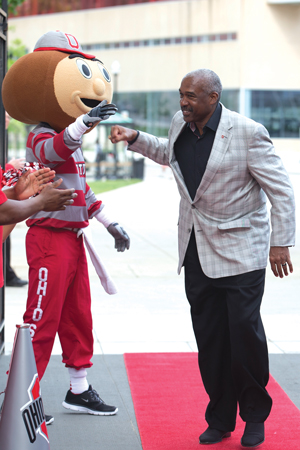 |
Smith is known for making personal connections that shape the Ohio State culture.
Photo by: Ohio State |
“I’ve seen problems at a lot of places where the decision-making was not as strong as you’d like.”
What Drake found was an athletic department that contributes nearly $40 million a year to the campus. About half of that pays for scholarships, but much of the rest goes toward the general fund or it is pledged for specific building projects, like the Thompson Library that used athletic funds for part of its $109 million renovation.
The Buckeyes are one of the few athletic departments that don’t take subsidies from the university.
“Every place has politics that you have to manage and nuances you have to understand,” said Miechelle Willis, Ohio State’s deputy AD. “Gene is very sharp at recognizing everyone’s role, from athletics to the university. He has the demeanor where he gets along with everybody, while never losing sight of his commitment.”
Committing $9 million of athletics money to the library fund is a big thing. But remember, Smith is mostly about the small things, the thousands of little gestures that add up over time and create a culture. Like a few weeks ago when the Buckeyes’ rowing team gathered at the boathouse for an early 6 a.m. meeting before catching a flight to California. Smith surprised the group by showing up and wishing them good luck.
“If you put the people part first, the business will follow,” said Sheila Smith, Gene’s wife, and a former fundraiser in higher education. As Smith often repeats: It’s not what you say, it’s how you make people feel. That line keeps coming up, whether he’s helping an athlete get a job or guiding a top aide to the AD’s chair.
“As someone in this business, you want a person like Gene running a department like Ohio State,” said Sandy Hatfield Clubb, the AD at Drake University and a former Smith assistant at Arizona State. “He gives me hope for the future of college athletics.”
Added Michigan’s Manuel: “Gene has helped to develop what athletic directors can and should do to lead programs.”
The following are winners of the National Association of Collegiate Directors of Athletics Under Armour AD of the Year Award. Winners will receive their awards at this week's NACDA annual convention in Dallas.
| Name |
Institution |
Division |
| Gary Barta |
University of Iowa |
Football Bowl Subdivision |
| Jim Phillips |
Northwestern University |
Football Bowl Subdivision |
| Scott Stricklin |
Mississippi State University |
Football Bowl Subdivision |
| Jim Sterk |
San Diego State University |
Football Bowl Subdivision |
| Thorr Bjorn |
University of Rhode Island |
Football Championship Subdivision |
| Dave Blank |
Elon University |
Football Championship Subdivision |
| Bill Chaves |
Eastern Washington University |
Football Championship Subdivision |
| Brad Teague |
University of Central Arkansas |
Football Championship Subdivision |
| Bob Driscoll |
Providence College |
Division I-AAA |
| Irma Garcia |
St. Francis College (NY) |
Division I-AAA |
| Jean Lenti Ponsetto |
DePaul University |
Division I-AAA |
| Jim Paquette |
Loyola University (MD) |
Division I-AAA |
| Bill Fusco |
Sonoma State University |
Division II |
| Jerry Hughes |
University of Central Missouri |
Division II |
| Lindsay Reeves |
University of North Georgia |
Division II |
| Brian Swanson |
Cal Poly Pomona |
Division II |
| Jason Fein |
Drew University |
Division III |
| Josh MacArthur |
Babson College |
Division III |
| Howard Patterson |
University of Texas at Tyler |
Division III |
| Dawn Stewart |
Otterbein University |
Division III |
| Mark DeMichael |
Indiana Wesleyan University |
NAIA |
| Gary Newsome |
Olivet Nazarene University |
NAIA |
| Matt Sayre |
Southern Oregon University |
NAIA |
| Ashley Walyuchow |
University of Houston, Victoria |
NAIA |
| Gary Broadhurst |
Mohawk Valley Community College |
Junior/Community College |
| Ron Case |
Rowan College at Gloucester County |
Junior/Community College |
| Marci Henry |
Northeastern Junior College |
Junior/Community College |
| Kulwant Singh |
De Anza College |
Junior/Community College |
Source: NACDA



